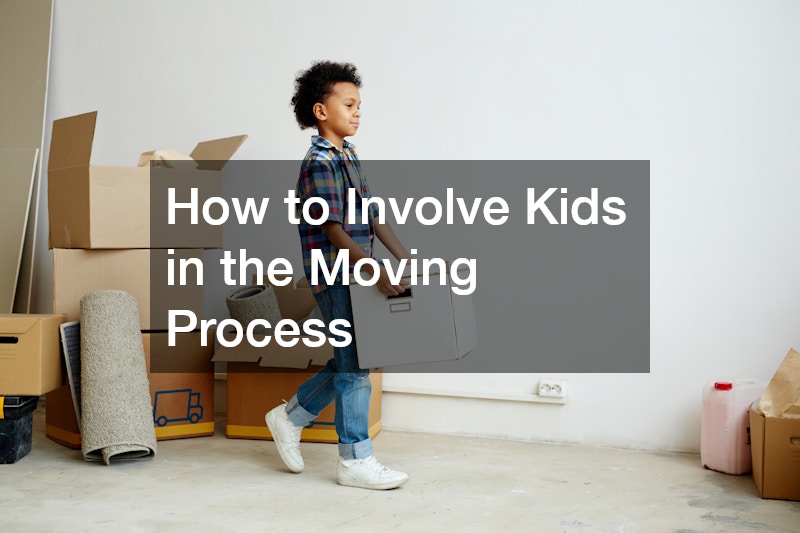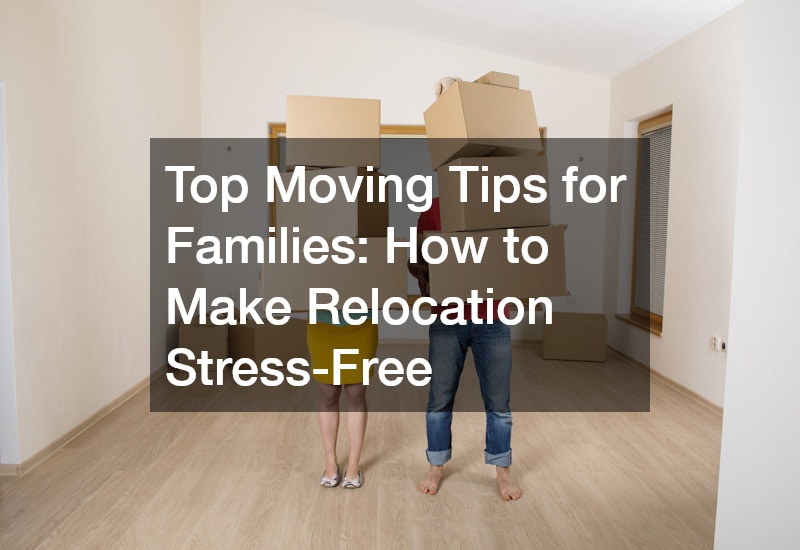Relocating with a family can be both exciting and challenging. A successful move requires careful planning, attention to detail, and strategies to ensure everyone in the household feels supported and prepared. Following practical moving tips for families helps reduce stress, prevent last-minute mishaps, and create a smoother transition for both adults and children. From selecting a reliable moving company to unpacking efficiently in your new home, every step matters.
How to Choose a Reliable Moving Company

Researching Moving Companies
One of the first steps in any relocation is finding a moving company that is reputable and trustworthy. Begin by looking for providers with strong local connections, positive reviews, and professional credentials. Checking for certifications, such as membership in moving associations or local business registrations, helps confirm their reliability. Many families also benefit from seeking recommendations from friends, neighbors, or local forums, ensuring they select a company familiar with the specific needs of family moves.
Requesting Quotes and Comparing Prices
Gathering multiple quotes from potential movers provides insight into pricing and services offered. Be sure to request detailed estimates that include labor, transportation, packing, and any additional fees. Comparing these quotes allows you to identify competitive rates while considering the quality of service. Keep in mind that the cheapest option is not always the best; reliability, experience, and professionalism are crucial when moving with a family.
Checking Reviews and References
Customer reviews and references are invaluable for gauging a company’s performance. Look for feedback on punctuality, professionalism, and care with belongings. Families often value companies that have experience handling delicate items such as children’s furniture, toys, and heirlooms. Asking for references enables you to speak directly with past clients and confirm the moving company’s claims.
Understanding Your Insurance Options
Even the most careful movers can encounter accidents. Understanding insurance options protects your possessions in case of damage or loss. Confirm the type of coverage offered by the moving company and whether additional insurance is advisable for valuable or fragile items, including electronics, artwork, or family heirlooms. This step is particularly important when relocating with children, as sentimental items often require special care.
Recognizing Common Moving Scams
Unfortunately, some companies engage in unethical practices. Be wary of businesses that require unusually large deposits up front or offer prices that seem too good to be true. Researching and verifying credentials, along with reading reviews, helps avoid falling victim to moving scams. Families benefit from choosing movers who maintain transparent communication and uphold a clear contract outlining services, costs, and responsibilities.
How to Pack Efficiently
Gathering Packing Supplies
Packing is one of the most time-consuming aspects of relocation. Start by gathering essential supplies such as sturdy boxes, packing tape, bubble wrap, and markers. Using high-quality materials protects your belongings during transit. Having ample supplies from the beginning prevents delays and reduces the stress of last-minute trips to the store.
Decluttering Before the Move
Moving provides an excellent opportunity to declutter your home. Evaluate items in each room and determine what to keep, donate, or discard. This process minimizes packing volume and reduces transportation costs. It also allows your family to start fresh in the new home, creating a more organized and manageable space.
Organizing Items by Category
Organizing belongings by category simplifies unpacking and ensures items are easier to locate once you arrive. Group similar items together, such as books, kitchenware, or clothing, and pack them in labeled boxes. Maintaining this organization benefits families, especially when moving with children, as toys, school supplies, and essential items remain accessible.
Labeling Boxes for Easy Identification
Labeling boxes is critical for efficient unpacking. Include the room designation and a brief description of contents on each box. Color-coding or numbering boxes can further simplify organization. Families can assign children to help with labeling, turning it into a collaborative effort that involves everyone in the moving process.
Packing Fragile Items Safely
Fragile items, including dishes, glassware, and electronics, require special care. Wrap each piece individually in bubble wrap or clothing, and use padding to fill empty spaces. Clearly mark boxes containing delicate items. Professional moving tips for families often emphasize this step to prevent unnecessary stress caused by broken belongings during transit.
How to Involve Kids in the Moving Process

Discussing the Move With Your Children
Honest communication helps children feel involved and reduces anxiety about relocating. Explain the reasons for the move, what to expect during the process, and the exciting opportunities in the new neighborhood. Families benefit when children are given a voice in the planning stages, fostering a sense of ownership and preparedness.
Assigning Age-Appropriate Tasks
Children can contribute by handling age-appropriate responsibilities. Tasks such as packing toys, labeling boxes, or organizing books teach responsibility and keep them engaged. Involving kids helps them feel included and less anxious about leaving behind familiar spaces.
Creating a Moving Day Schedule for Kids
Developing a moving day schedule tailored to children’s needs ensures smoother transitions. Incorporate breaks, snack times, and activities to keep them occupied. Maintaining a structured schedule prevents boredom and stress, making the day more manageable for both parents and children.
Making the Move Feel Like an Adventure
Framing the move as an exciting adventure helps children embrace change positively. Highlight fun aspects such as exploring new parks, trying local restaurants, or visiting nearby attractions. Positive reinforcement can ease apprehension and foster enthusiasm for the new environment.
Helping Kids Say Goodbye to Friends
Leaving behind friends can be emotional for children. Organize small gatherings or farewell activities to provide closure. Exchanging contact information and scheduling future visits or video calls helps maintain important connections, supporting a smoother adjustment in the new location.
What to Do Before Moving Day
Preparing a Moving Checklist
Creating a moving checklist keeps tasks organized and ensures nothing is overlooked. Include everything from notifying service providers to packing specific items. Checklists provide structure, helping families stay on track and reducing last-minute stress.
Notifying Important Contacts
Inform important contacts about the move, including banks, schools, day care centers, and healthcare providers. Updating your address with local service providers ensures continuity of care and prevents missed correspondence. Families relocating with children must prioritize notifying educational institutions to facilitate seamless transitions.
Scheduling Utility Shut-Offs and Set-Ups
Coordinate utility shut-offs at your old home and set-ups at your new one. Services such as electricity, water, internet, and gas should be scheduled to avoid disruption. Families benefit from completing these tasks early, preventing inconvenience during the hectic moving period.
Packing an Essentials Bag for the Family
Prepare an essentials bag containing important documents, medications, snacks, clothing, and entertainment items for children. Having these items accessible on moving day prevents unnecessary stress and ensures comfort throughout the relocation.
Confirming Moving Details With Movers
Confirm arrival times, contact information, and special instructions with your moving company. Clear communication reduces confusion and ensures a smooth operation, giving families confidence that all logistics are handled efficiently.
How to Handle Moving Day Like a Pro

Starting the Day Early and Staying Organized
Begin moving day early to maximize time and minimize stress. Having a structured plan ensures tasks are completed efficiently and allows for adjustments if unforeseen issues arise. Families can maintain calm by keeping essential items organized and ready for transport.
Coordinating With the Moving Team
Communicate clearly with movers regarding fragile items, entry door repair requirements, or any special handling needs. Collaboration with the moving team ensures smooth handling of belongings, including furniture, electronics, and household items.
Keeping Track of Moving Documents
Keep contracts, receipts, and inventories in a secure folder. Access to these documents is essential in case of disputes or questions regarding services. Families benefit from organized records, especially when relocating with children or pets.
Managing Stress and Taking Breaks
Moving is physically and emotionally demanding. Schedule breaks for meals, snacks, and rest to prevent exhaustion. Families should prioritize hydration and nutrition to maintain energy and positivity throughout the day.
Final Walkthrough of the Old Home
Conduct a final walkthrough to ensure nothing is left behind. Check closets, cabinets, and storage spaces. This step confirms accountability and prevents forgotten items, providing peace of mind before departing.
How to Settle Into Your New Home
Creating an Unpacking Plan
Develop a room-by-room unpacking strategy. Start with essentials such as bedding, kitchen items, and toiletries. Families can tackle one area at a time, reducing the feeling of being overwhelmed and facilitating a smoother transition.
Essential First-Day Preparations
Prioritize immediate needs, including setting up beds, preparing meals, and arranging a safe environment for children. Completing these tasks ensures comfort and stability on the first night in the new home.
Familiarizing With Your New Neighborhood
Explore the surrounding area to locate important services such as local barber shops, day care centers, local dentist offices, and restaurants. Familiarity with these resources helps families adapt quickly and establish a sense of community.
Introducing Kids to Local Attractions
Visiting local attractions like a nearby local gymnastics center or public parks makes the new environment exciting. Activities that engage children encourage exploration and help them form positive associations with their new surroundings.
Setting Up Home Security
Ensure safety by checking locks, alarm systems, and any required entry door repair. A secure home provides peace of mind, especially when children are present, and establishes a comfortable environment for the family.
How to Help Children Adjust After the Move
Re-establishing Routines and Rituals
Maintaining familiar routines, such as bedtime schedules or after-school activities, provides stability for children. Consistency helps reduce anxiety and fosters a sense of security in the new environment.
Enrolling Kids in Local Activities
Engaging children in local activities, such as gymnastics classes at a local gymnastics center or social programs at a day care center, facilitates social interaction and eases adaptation. Participation promotes confidence and creates opportunities to make new friends.
Meeting New People and Making Friends
Encourage children to connect with peers at school, playgrounds, and extracurricular activities. Parents can also build networks by meeting neighbors and participating in local events, enhancing family integration into the community.
Encouraging Open Communication
Invite children to share their feelings about the move. Acknowledging concerns and offering reassurance fosters trust and emotional resilience. Families benefit when children feel heard and supported during transitions.
Seeking Professional Support if Needed
If children experience difficulty adjusting, consider professional guidance from counselors or psychologists. Early intervention can prevent long-term stress and ensure healthy emotional development.
How to Manage Moving With Pets

Preparing Pets for the Move
Gradually acclimate pets to carriers, travel routines, and new environments. Proper preparation reduces stress and ensures pets are comfortable on moving day.
Ensuring Safety on Moving Day
Keep pets secure and supervised during the move. A calm environment minimizes risk and prevents accidents or escapes.
Setting Up a Pet-Friendly Space
Designate a safe area in the new home with familiar bedding, toys, and food. This space allows pets to acclimate gradually and reduces anxiety.
Helping Pets Adjust to the New Environment
Introduce pets to their surroundings in stages, including backyard exploration and indoor familiarization. Positive reinforcement encourages comfort and security.
Registering Pets With Local Authorities
Update identification tags and local registrations as required. Ensuring pets are legally documented prevents future complications and ensures access to veterinary services in the new area.
How to Handle Emotional Stress During a Move
Recognizing Common Stressors
Moving can trigger anxiety due to packing demands, logistics, and emotional transitions. Recognizing sources of stress allows families to develop strategies for coping.
Practicing Mindfulness and Relaxation Techniques
Mindfulness exercises, meditation, and relaxation techniques reduce tension and foster calm. Families benefit from integrating these practices throughout the moving process.
Maintaining a Support Network
Stay connected with friends, family, and local contacts for support. Sharing experiences and receiving assistance alleviates feelings of isolation and pressure.
Finding the Positives in Moving
Focus on the opportunities offered by the new home, such as access to local chimney cleaner services, pool cleaning services, and restaurants. Positive framing helps families embrace change and reduces emotional strain.
Keeping the Family Motivated
Celebrate milestones and progress throughout the move. Acknowledging small achievements encourages cooperation and maintains morale during challenging stages.
How to Budget for Your Move
Estimating Moving Costs
Accurately projecting expenses, including hiring movers, packing supplies, and professional services like carpet cleaning service or upholstery cleaning service, ensures preparedness and prevents financial surprises.
Identifying Cost-Saving Opportunities
Look for ways to reduce expenses, such as donating unwanted items, using free boxes, or scheduling moves during off-peak times. Families benefit from balancing quality services with affordability.
Tracking Moving Expenses
Maintain a detailed record of all costs incurred, including fees for entry door repair, local barber shops, or local dentist visits in the new area. Monitoring expenses allows for accountability and informed budgeting.
Prioritizing Necessary Versus Luxury Services
Distinguish between essential services and optional extras. Prioritizing items that directly affect family comfort and safety ensures funds are allocated efficiently.
Planning for Hidden Moving Costs
Anticipate unexpected expenses, such as last-minute repairs, additional packing supplies, or pet care during transit. Preparation prevents financial stress and ensures a smoother relocation.
Following practical moving tips for families ensures a well-organized, low-stress relocation. From researching reliable movers to unpacking efficiently, involving children, managing pets, and budgeting, every detail matters. Families can benefit from accessing local services such as day care centers, local gymnastics centers, local barber shops, and pool cleaning services to make the transition seamless. By staying organized, communicating openly, and prioritizing both safety and comfort, moving becomes an opportunity for growth, adventure, and a fresh start. Applying these strategies enables families to settle quickly into their new home, explore nearby amenities like restaurants, local dentists, and local chimney cleaners, and create a welcoming, enjoyable environment for everyone.

